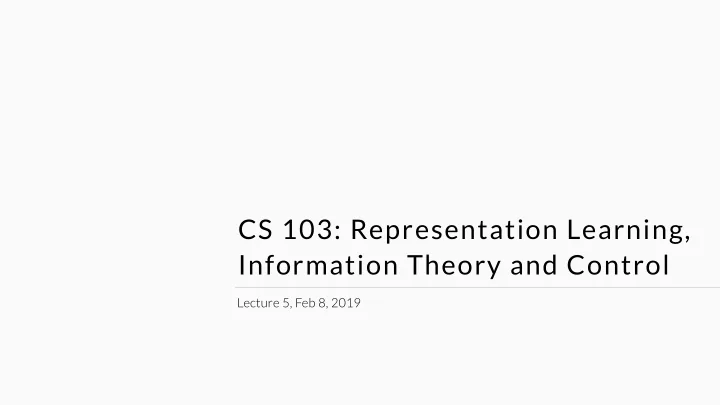

CS 103: Representation Learning, Information Theory and Control Lecture 5, Feb 8, 2019
Representation Learning and Information Bottleneck
Desiderata for representations An optimal representation z of the data x for the task y is a stochastic function z ∼ p(z|x) that is: I(z; y) = I(x; y) Sufficient Minimal I(x; z) is minimal among sufficient z If n ⫫ y , then I(n; z) = 0 Invariant to nuisances Maximally disentangled is minimized TC ( z ) = KL( p ( z ) k Q i p ( z i )) Sufficient Minimal 3
Information Bottleneck Lagrangian Minimal sufficient representations for deep learning A minimal sufficient representation is the solution to: minimize p ( z | x ) I ( x ; z ) H ( y | z ) = H ( y | x ) s.t. Information Bottleneck Lagrangian: L = H p,q ( y | z ) + β I ( z ; x ) cross-entropy regularizer Trade-off: between sufficiency and minimality, regulated by the parameter. 4
Invariant if and only if minimal We only need to enforce minimality (easy) to gain invariance (difficult) Proposition. (A. and Soatto, 2017) Let z be a sufficient representation and n a nuisance. Then, I ( z ; n ) ≤ I ( z ; x ) − I ( x ; y ) invariance minimality constant Moreover, there exists a nuisance n for which equality holds. A representation is maximally insensitive to all nuisances iff it is minimal 5
Corollary: Ways of enforcing invariance The standard architecture alone already promotes invariant representations Regularization by architecture Reducing dimension (max-pooling) or adding noise (dropout) increases minimality and invariance. Only nuisance information dropped 1 in a bottleneck (sufficiency). Nuisance information The classifier cannot overfit to nuisances. 3 I(x; n) Task information Increasingly more minimal implies I(x; y) 2 increasingly more invariant to nuisances. Stacking layers Stacking multiple layers makes the representation increasingly minimal. 6
Information Dropout: a Variational Bottleneck Creating a soft bottleneck with controlled noise L = H p,q ( y | z ) + β I ( z ; x ) = H p,q ( y | z ) − β log α ( x ) bottleneck Nuisance information I(x; n) Task information I(x; y) Multiplicative noise ~ N(0, 𝛽 (x)) Achille and Soatto, "Information Dropout: Learning Optimal Representations Through Noisy Computation” , PAMI 2018 (arXiv 2016) 7
Learning invariant representations ( Achille and Soatto, 2017) Deeper layers filter increasingly more nuisances Stronger bottleneck = more filtering Only informative part of the image Other information is discarded Achille and Soatto, "Information Dropout: Learning Optimal Representations Through Noisy Computation” , PAMI 2018 (arXiv 2016) 8
Recommend
More recommend